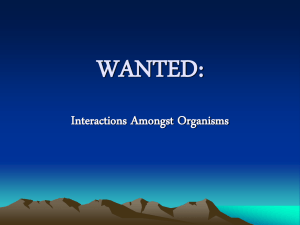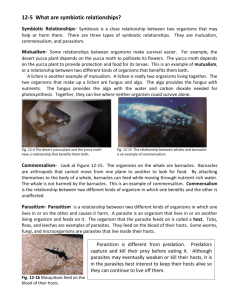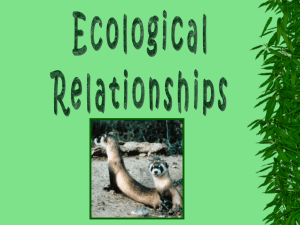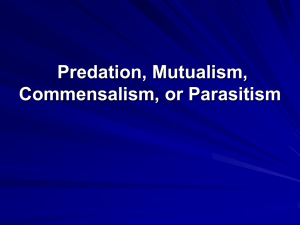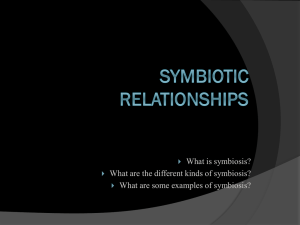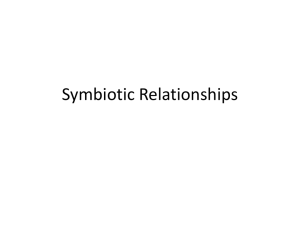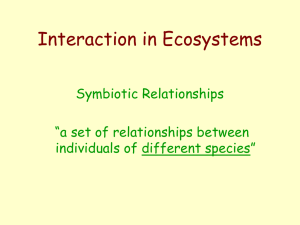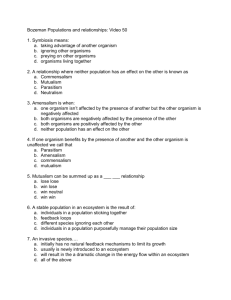Symbiotic Relationships Quiz
advertisement
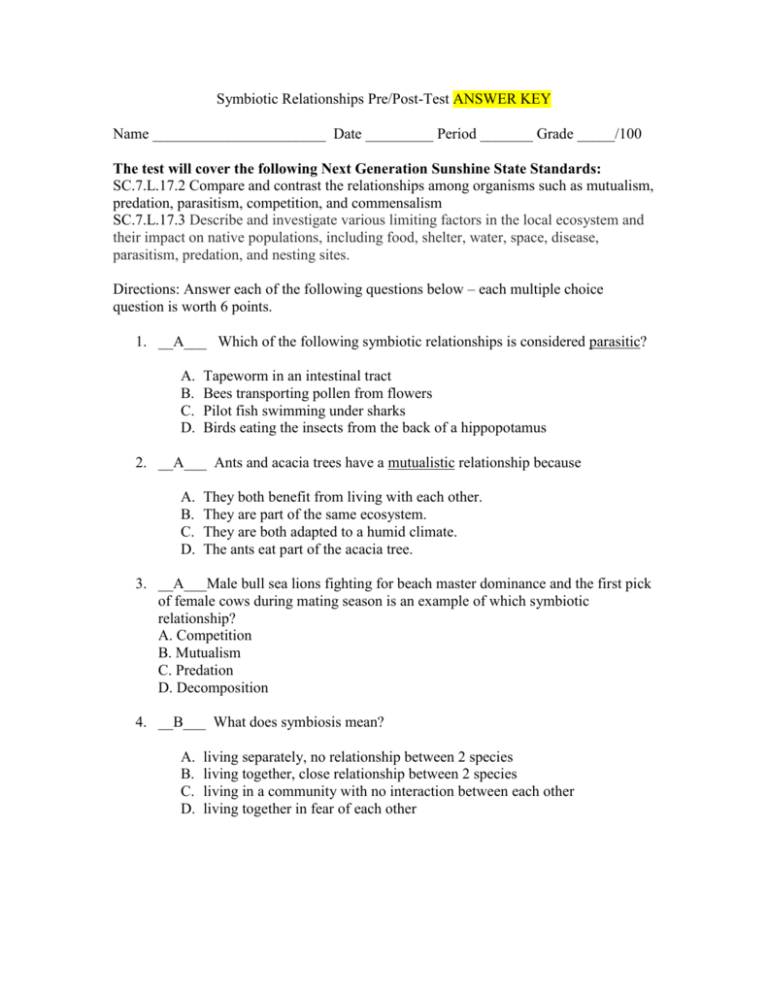
Symbiotic Relationships Pre/Post-Test ANSWER KEY Name _______________________ Date _________ Period _______ Grade _____/100 The test will cover the following Next Generation Sunshine State Standards: SC.7.L.17.2 Compare and contrast the relationships among organisms such as mutualism, predation, parasitism, competition, and commensalism SC.7.L.17.3 Describe and investigate various limiting factors in the local ecosystem and their impact on native populations, including food, shelter, water, space, disease, parasitism, predation, and nesting sites. Directions: Answer each of the following questions below – each multiple choice question is worth 6 points. 1. __A___ Which of the following symbiotic relationships is considered parasitic? A. B. C. D. Tapeworm in an intestinal tract Bees transporting pollen from flowers Pilot fish swimming under sharks Birds eating the insects from the back of a hippopotamus 2. __A___ Ants and acacia trees have a mutualistic relationship because A. B. C. D. They both benefit from living with each other. They are part of the same ecosystem. They are both adapted to a humid climate. The ants eat part of the acacia tree. 3. __A___Male bull sea lions fighting for beach master dominance and the first pick of female cows during mating season is an example of which symbiotic relationship? A. Competition B. Mutualism C. Predation D. Decomposition 4. __B___ What does symbiosis mean? A. B. C. D. living separately, no relationship between 2 species living together, close relationship between 2 species living in a community with no interaction between each other living together in fear of each other 5. __A___ What type of relationship is Commensalism? A. B. C. D. One species benefits and the other is not affected at all. Both species involved benefit from the relationship. One species benefits and the other is harmed. Competing for the same food source 6. Match the following Picture (representation) to the Correct Symbiotic Relationship by drawing a line from the word to the picture that matches the relationship A. Mutualism A B. Parasitism B C. Commensalism C Question 6 answers: 2 points each = Total 6 points A. _C__________ B _B__________ C._A__________ 7. __C___ What type of symbiotic relationship is shown in this picture? A. B. C. D. mutualism predation parasitism commensalisms 8. __D____ A remora hitching a ride on the shark is an example of which symbiotic relationship? A. B. C. D. Predator/prey Mutualism Parasitism Commensalism 9. Explain and define what type of relationship this is and give 2 examples of why it is that symbiotic relationship by discussing how each individual organism is directly affected by the other organism. Provide another example of organisms sharing the same symbiotic relationship as the hummingbird moth and flower. (16 total points) Category Identify Correct Relationship – explaining the definition 4 Correctly identifies the symbiotic relationship providing an accurate definition of the term. Example 1 – can refer to either organism (hummingbird or flower) Specifically and accurately identifies how organism 1 directly benefits from the symbiotic relationship Specifically and accurately identifies how organism 2 directly benefits from the symbiotic relationship Identifies 2 organisms that shares the same type of symbiotic relationship – both must benefit Example 2 – must refer to other organism (not discussed in example 1) Another example of the symbiotic relationship 3 Correctly identifies the symbiotic relationship but does not provide an accurate definition of the term. Partially identifies how organism 1 might benefit from the symbiotic relationship 2 Does not correctly identify the symbiotic relationship but provides a correct definition of the term given Incorrectly identifies how organism 1 benefits by the symbiotic relationship. 1 Does not identify the correct symbiotic relationship and lacks a definition of term. Partially identifies how organism 2 might benefit from the symbiotic relationship Incorrectly identifies how organism 2 benefits by the symbiotic relationship. Does not mention the benefit experienced to organism 2. Identifies 2 organisms that share a relationship but not the same symbiotic relationship as the organisms Does not identify 2 organisms that share a symbiotic relationship Ex. Cat and dolphin Only discusses 1 organism and makes no mention of a shared relationship with another organism. Does not mention the benefit experienced to organism 1. in the picture. A B C D F 15-16 13-14 12 10-11 Less than 10 Note: Answers will vary but should include the mutualistic relationship between the flower being pollinated and the hummingbird moth receiving nectar (food). Answer must meet grading rubric criteria to receive full credit in each required area of the question. 10. __A___ Which of the following relationships identifies a situation in which two species share a requirement for a limited resource thus reducing the fitness of one or both species? A. Competition B. Mutualism C. Parasitism D. Decomposition 11. _D____ A hawk soaring above a field hunting for a field mouse is an example of which relationship? A. Commensalism B. Mutualism C. Symbolism D. Predation 12. ___B___ A. Commensalism B. Mutualism C. Symbolism D. Predation is an example of which relationship? 13. __D____ A. Commensalism B. Mutualism C. Symbolism D. Predation 14. __C___ A. Commensalism B. Mutualism C. Competition D. Predation is an example of which relationship? is an example of which relationship? 15. __D___ The bacteria in our large intestine break down food that we consider waste. During this process, vitamins are released that we absorb into our bloodstream. This is an example of which symbiotic relationship? A. Parasitism B. Commensalism C. Competition D. Mutualism
